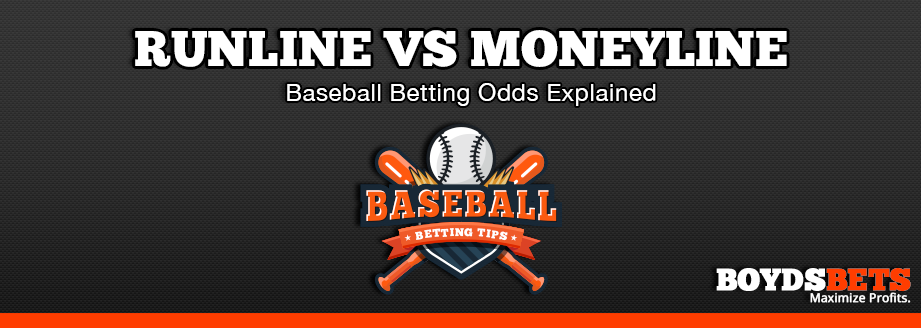When it comes to betting on baseball you have two primary options for betting sides. The first, and most common, is the moneyline. The other option is to bet what is called the runline. Both options can present some unique opportunities. Let’s look at what each bet type entails and explore which is the better option.
How MLB Moneyline Bets Work
The moneyline is the simplest form of baseball betting, which also makes it the most popular. To win a money line bet, you need to pick the correct team to win the game outright. The catch is that oddsmakers adjust the price of each team based on the estimated probability that team has to win the game.
With every moneyline, there is a favorite and an underdog (unless the odds are even, which typically means both teams are listed at -110 money line odds). The favorite is always represented with a negative price (just like the favorite in point spread sports), while the underdog is represented with a positive number.
The easiest way to conceptualize how pricing on moneylines works is to think in terms of $100 bets. With favorites, the price is the amount needed to risk to win $100. With underdogs the price is the amount paid on a $100 bet. Here’s an example:
[Underdog] Cubs +140 [Favorite] Cardinals -160
Using these prices, you would need to wager $160 to win $100 on the Cardinals, while a $100 bet would pay $140 on the Cubs.
Baseball Runline Betting Explained
The run line works a bit like a point spread. The biggest difference between baseball and sports that use point spreads is that there is a standard spread of -1.5 for favorites and +1.5 for underdogs for every game (some books do offer alternate runlines, however, we will just focus on the standard option, which nearly everyone has access to). You can read our run lines explained article for full details on this wager type.
What this means is that, for a runline bet to win on a -1.5 favorite, that team has to win and win by 2 or more runs. For a winning bet on a +1.5 underdog, your team must win outright or lose by exactly 1 run.
Pricing on spread sports like football is almost always something like -110 (10% vig). In baseball, the odds prices are adjusted since the runline is a fixed number. Now let’s break down an example of fictional a run line:
[Underdog] Red Sox +1.5 -185 [Favorite] Yankees -1.5 +165
The first thing you’ll notice is that the odds pricing on underdogs and favorites is reversed here. You could bet $100 on the Yankees -1.5 and if they win by 2 or more runs, your bet pays $165. Meanwhile, you’d need to wager $185 on the Red Sox in order to get a $100 return, provided they win the game outright or lose by 1 run.
Why Runline Odds Aren’t as Good as You Think
The vast majority of amateur bettors look at the runline option and instantly perceive value in taking a big favorite at -1.5 with a better payout. What’s that they say about something that looks too good to be true?
For starters, you have to know that sportsbooks are anything but stupid. These are multi-million dollar operations that spend a good chunk of their profits on making sure they have an edge over the player. This means they are not going to simply hand you an easy way to make money.
The crucial factor here is the fixed -1.5/+1.5 spread.
How Many MLB Games are Decided by 1 Run
We have run the numbers on every baseball game since 2004 (over 35,000 games in total) and found that 28.65% of all MLB games are decided by exactly 1 run. This number fluctuates a bit from about 26% to as high as 31% from season to season, but you can assume in any given year that 28%-29% of games will end with a 1 run margin of victory.
How does that factor into the runline? I’m glad you asked! Using our handy odds calculator, let’s look at an example where there is a favorite of -125 and find the implied probability of that team winning. At -125, oddsmakers are saying that a team has roughly a 55.6% chance of winning that game. If you think a team has at least that good of chance of winning, this is a good bet.
Let’s say you decide to take this team on the runline instead. They have a 55.6% chance of winning, and the game has a 28.65% chance of being decided by 1 run. This gives you an estimated probability of just 39.64% (55.6% * 71.35%) of your team winning by more than 2 runs. If you still like a team in this situation, by all means take them, we just want you to be aware of the built in probability hit your odds take by taking a favorite on the runline.
Betting Home Teams on the Runline
Because of the way baseball games are structured, you also need to be aware of the difference between taking a home team versus a road team on the runline. Home teams always bat last and a game ends in or before the bottom of the 9th inning as soon as the home team is up by at least one run. This structure causes more home teams to win by exactly 1 run that teams do on the road. The MLB average is 28.65%, but when the home team win that number jumps to 32.06%, while a road team wins by exactly 1 run just 24.65% of the time.
This shouldn’t discourage you from ever taking runline bets versus the moneyline, however, you should now be more aware than ever of the differences between these types of baseball bets.

